Like many nations, Sri Lanka is faced with the problem of waste management. We followed the daily activities of experts in Sri Lanka tackling this problem with Japanese technology and vision.
Photography: Yusuke Abe
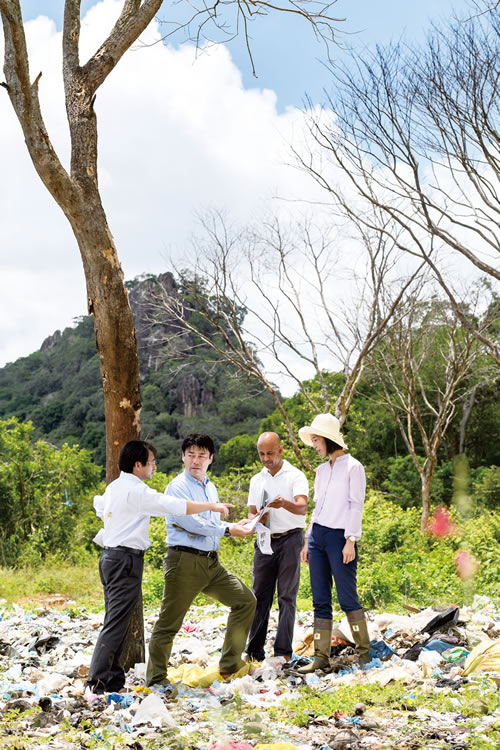
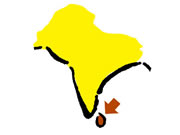

Democratic Socialist Republic of Sri Lanka
Capital: Sri Jayawardenepura Kotte
Currency: Rupee
Population: Approx. 21.03 million (as of 2016)
Official Language(s): Sinhalese and Tamil
Link Language: English
[Project Introduction]
Experts in Pollution Control and Reduction of Environmental Burden in Solid Waste Management
(February 2017 - February 2019)
JICA Expert Yoko Onuma is collaborating with a team, including Naofumi Sato from the EX Research Institute and consultants from Kokusai Kogyo Co., Ltd., to improve the environment through appropriate waste management by creating guidelines for final disposal sites based on pollution control techniques for landfills developed by Japanese and Sri Lankan researchers. Cooperation is underway in the three local authorities of Kurunegala Municipal Council, Ratnapura Municipal Council, and Kataragama Pradeshiya Sabha, according to their respective local characteristics.
As a participant in the JICA technical cooperation project, consultant Naofumi Sato recalls his first visit to Sri Lanka in 2002, "At that time, the streets were filled with garbage, and there were sanitary problems. However, Sri Lanka has changed greatly over the past 10 years. Citizen awareness has also changed as a result of steady long-term activities such as giving advice and suggestions for waste segregation and collection to government agencies. Intermediate treatments such as composting (making compost by fermenting kitchen waste), which had only been implemented in about 10 local authorities, are now being carried out in 120 of the 335 local authorities in the country. Sanitation in the towns has gradually improved, and we're now at the stage of planning final disposal sites that will reduce environmental impact."
Since the Sri Lankan government established the National Strategy for Solid Waste Management in 2000, it has been working on solving problems in this field; however, there are some issues peculiar to the country. Yoko Onuma, who works for the Central Environmental Authority (CEA) in Sri Lanka as a JICA Expert, explains that, "The main final disposal sites in Sri Lanka practice the environmentally burdensome open dumping method, where pits are dug and filled with waste. In the Western Province, where the country's largest city of Colombo is located, around 2,100 tons of garbage a day are sent to the landfill. Sri Lanka is an island nation with many mountains and wetlands, placing limitations on the amount of land that can be converted to disposal sites. Moreover, local residents oppose such efforts due to concerns over offensive odors and risk of health hazards."
Developing new sustainable, low-cost technology: that effectively tackles the challenge of waste management has been a long process for the Sri Lankan government and JICA. Commencing with a survey in 2002, they have been cooperating in structural developments and training-based human resource development in local authorities. In 2011, they implemented the "Project for Development of Pollution Control and Environmental Restoration Technologies of Waste Landfill Sites Taking into Account Geographical Characteristics in Sri Lanka" with Saitama University and other organizations. This project, which ran for a period of five years, created sustainable and applicable guidelines for planning, managing, and preventing pollution at waste disposal sites. It also developed technologies for low-cost, low-maintenance and low-environmental impact facilities using materials that can be procured locally.
Onuma is currently providing support for a trial implementation of the guidelines in three local authorities. Working hard every day, she says she wants to help improve the capabilities of the relevant institutions in Sri Lanka, as a basis for the proper implementation of guidelines nationwide in the future.
"There was a major landslide at a final disposal site called Meethotamulla last year. It's an open dumpsite that has been a dumping ground for Colombo's garbage. It was a major disaster; 32 people died, and 418 families were affected. The danger of collapse had been pointed out for some time, and there was even an evacuation advisory issued several days before the incident due to the continuous rain. The accurate advice provided by the experts from the Japan Disaster Relief team right after the accident was truly encouraging to the locals. It happened soon after I assumed this post, and I was uneasy because I still did not have a feel for the place. Regardless, I did my best to coordinate with the relevant officials. This incident showed not just the Sri Lankan government officials, but also the citizens, the importance of waste management. As a specialist, I am trying to tackle the issues faced by the Sri Lankan government, for example, by suggesting concrete ways to make improvements based on objective data about waste management."
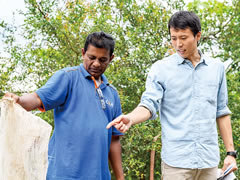
The composting plant at Kataragama's waste disposal site. Kitchen waste and recyclable materials are separated from the mixed waste.
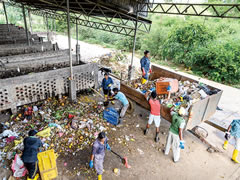
Site manager Ariyapala and Japan Overseas Cooperation Volunteer Shinya Inoue having a discussion at the composting plant in Kataragama
Yoko Onuma, JICA Expert

Onuma is currently engaged in technical cooperation in three areas of Sri Lanka in order to implement guidelines. Narrowing down the candidate local authorities from all over the country from 2015 to 2016, she and other experts toured disposal sites and selected the three areas based on the environment and enthusiasm of the local authorities. She is helping the local authorities by giving advice on maintaining and managing the disposal sites and performing repairs and improvements, so that in the future they can continue the activities independently. She intends to prepare a manual based on the results of activities in these three local authorities, as well as cooperate with CEA to spread the activities all over the country.
Final disposal site in Karadiyana
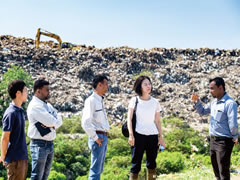
Left to right: Japan Overseas Cooperation Volunteer Akifumi Kanachi provides advice to local administrations and holds environmental lectures at schools; Ranuka Gunawardhana; Nadeeka Edirisinghe of Recycle; Yoko Onuma; and Dhanuka Wijerathne (manager of the Karadiyana final disposal site, WMA).
This open-dump waste disposal site is the dumpsite for seven local authorities in the Western Province. It receives around 500 tons of waste per day. Data is collected by each local authority to manage the volume of waste. In February 2018, an automated sorting machine was installed as part of JICA's "Verification Survey with the Private Sector for Disseminating Japanese Technologies for Municipal Solid Waste Material Recovery Facilities." Using technology for highly accurate sorting of valuable resources and compost material, it collects resources from the mixed waste delivered to the disposal site and produces compost. This project was designed to improve environmental sanitation by addressing problems such as foul odors and water contamination; it also aims to produce quality, organic compost and mitigate soil degradation. Nadeeka, who works for Recycle (headquarters in Chiba), the company that operates the facility, says with hope, "Someday, I want to make compost that is optimal for each crop, whether it be vegetables or rice."
Developing facilities that are low-cost,
easy to maintain, and can be operated long term
Everyone's awareness will help change society:
Those who take out waste;
Those who collect it; and
Those who process it.
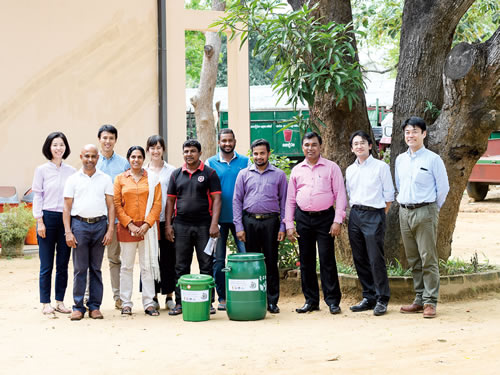
Colleagues working together to improve waste management in Kataragama Pradeshiya Sabha. There are high expectations for the efforts being promoted by the team, which includes city staff and specialists from Japan.
Professor Ken Kawamoto of the Graduate School of Science and Engineering, Saitama University, actively works as a specialist in the establishment of measures to prevent soil and groundwater contamination, as well as technologies for restoring waste disposal sites in Sri Lanka and other Asian countries. He prepared guidelines in cooperation with JICA, and has done research on water purification technology and pollution prevention utilizing the locally and readily available coconut fiber, coconut shell charcoal, geomaterials with high heavy metal adsorption properties, and expansive clay.
"How do we make sure that the Sri Lankan government can manage and implement the guidelines by itself when support from Japan comes to an end? As a fellow island country, Japan's waste management method is effective, although not everything can be applied. Take the water-sealing material used to prevent leachate (contaminated water from waste disposal sites) from seeping into the ground as an example; the material used in Japan is too expensive for Sri Lanka, so it can't always be used. That is what made me think about using Sri Lanka's very own expansive clay as a water-sealing material. We have to build facilities that are capable of performance similar to large-scale facilities, while keeping them low-cost and low-maintenance. Like with medicine, generic construction would work. Since Sri Lanka is larger than Kyushu but smaller than Hokkaido in Japan, disposal facilities that are easy to oversee and are on a manageable scale are appropriate, especially when the limited number of workers in this field is considered. Moreover, in order to ensure a sustainable operation of the facilities, it's essential that we become thoroughly familiar with the natural features of each region and build facilities that address those in detail."
Kataragama Pradeshiya Sabha, a town in southern Sri Lanka with a population of around 22,000, is one of the local authorities currently receiving cooperation from a team of JICA Experts. Located next to a national park, this town is home to a temple that is sacred to the Sri Lankan people; so during festivals, as many as a million people come from all over the country. Their disposal facility had problems dealing with the large amount of garbage thrown out by visitors, a problem compounded by the 60 wild elephants living nearby that would rummage through the waste. At the same time, Sato explains, "At facilities that do not control seepage, leachate seeps into the soil and contaminates groundwater." Standing at the planned site for Kataragama's disposal facility, he points out the difficulty of implementing measures against the impact of waste disposal on the environment.
"Subsoil water (underground water veins) in some parts of the town is contaminated according to the numbers, so we regularly survey the water quality."
At the improvement site, local clay was used for seepage control, and an electric fence was installed to keep elephants out. Taking advantage of its location at the base of a mountain, the design will allow collection of leachate via the natural grade, without using motorized pumps and other equipment. The collected leachate will then be treated using coconut fibers.
"We also plan to introduce a treatment facility for raw sewage dumped at the disposal site. Treated sewage water will be used for the bacterial reactions required to make compost. Moreover, the sludge generated by the sewage treatment process contains nitrogen and phosphorus, which are important for plant growth; we will mix the sludge with the compost to increase its value." These are just some of the measures developed to effectively utilize waste and make them useful in daily life.
Even the elephants...
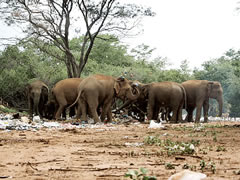
More and more elephants are suffering from health problems due to ingestion of plastic bags and other garbage that cannot be digested.
Indrarathna, Deputy Director General, Central Environmental Authority
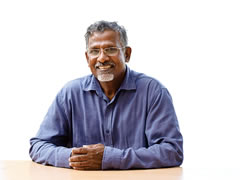
The guidelines prepared in cooperation with JICA are based on advanced technology that is very important for reducing costs and environmental impact. In fact, the guidelines are now being used to improve disposal sites through the utilization of the countryfs resources and technical know-how. We are currently waiting on a report which will tell us the degree to which costs were reduced, and how much improvement was made with respect to contamination at the disposal sites. We hope to use the same technology for other disposal sites in the country based on the results.
Jayathilaka, Secretary, Kataragama Pradeshiya Sabha
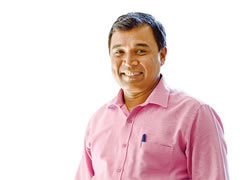
Kataragama Pradeshiya Sabha is a unique town in Sri Lanka. Many people visit this place as it is sacred to Buddhists, Hindis, and Muslims. We used to do waste management operations without a plan, so we were unable to handle the increase in the amount of waste prior to receiving JICAfs cooperation. JICA is currently tackling various issues to realize systematic, efficient waste management in this location. We are now facing the challenges to establish an effective waste disposal system together with citizens.
Sustainable waste management starts
with effective utilization of waste
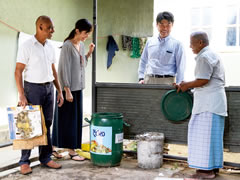
Composting waste.
Thoroughly promoting reuse!
A composting bucket at a hotel in Kataragama Pradeshiya Sabha. Left to right: Layan Gunasekara, who coordinates and does activities with the town of Kataragama Pradeshiya Sabha and its residents five days a week; Chiharu Iida and Naofumi Sato from the EX Research Institute; and the hotel owner who placed a customized sticker on the bucket to ensure proper sorting.
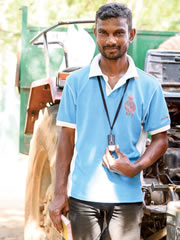
Improving efficiency with GPS!
A worker heading out to collect waste carries a GPS device with the aim of improving the efficiency of waste management, such as by eliminating the inadvertent skipping of areas.
In Sri Lanka, household waste is largely divided into kitchen waste and mixed waste. Starting the segregation and composting of kitchen waste is essential, as kitchen waste accounts for around 60% of the waste in the country. In addition, the demand for compost is high in Sri Lanka's thriving agriculture industry.
CEA Deputy Director General Indrarathna talks of its importance, "In 2016, the Kandy District brought in composting machines made by the Japanese manufacturing company Kawashima Co., Ltd., (based in Gunma). Currently, the Ministry of Local Government and Provincial Councils is making plans to introduce that machinery nationwide and, in the future, make compost across wide areas." This is also a good example of how the technology of Japanese SMEs introduced through JICA's cooperation has been recognized locally and spread.
Although in place for some time, the system for segregation and collection of kitchen waste in Kataragama Pradeshiya Sabha had not been very successful. Secretary Jayathilaka says, "In conjunction with the improvements currently underway at the disposal site, we are collecting basic data on waste and promoting ongoing efforts to change the attitude among residents. I feel that the residents are becoming more aware of the 3R's (reduce, reuse, recycle). Last year we held a contest for schools and Buddhist institutions, such as Sunday schools, to come up with a logo and slogan for promoting the 3R's. More people are becoming aware of the 3R's thanks to the combined efforts of everyone involved."
3R activities are currently being promoted in two areas of the town. While looking at segregated garbage being collected in the town, Sato says with a smile, "Many people are involved in waste management, from segregation to treatment. It's important that those throwing out waste make an effort to limit the amount of waste they produce and become aware of the need to segregate it. Those involved in waste treatment also need to take pride in their work. The only way to achieve this is to keep having discussions and gain the people's understanding. When it comes to maintaining waste management, everything depends on the people." He is busy making preparations so that the local authority can run the operations by itself in the future, while providing guidance on matters such as efficient waste segregation, usage of compost at one's home, and measurement of the total volume of waste at the disposal site.
In November 2017, Onuma invited a waste management officer from Shibushi City, Kagoshima Prefecture to Sri Lanka. She hoped it would help the locals get a feel of the process if the officer tells them about the state of segregation and collection in Shibushi City. With a population of around 30,000, Shibushi City does not have an incineration facility and instead processes its waste through segregation, collection, and resource recovery. The citizens have come together to segregate their waste into 29 categories as part of the city's waste management operations.
Considering their limited land area and inability to construct incineration facilities, segregation and collection will be a major key to success in the small- and medium-sized local authorities of Sri Lanka. Impressed by Shibushi City's efforts, staff members from CEA and Sri Lankan local authorities visited Shibushi City in February 2018 of their own accord. Members of the group who saw the city's efforts firsthand were inspired by the fact that the measures were mainly led by the municipality and not the national government; that the population of the city was similar to that of small- and medium-sized local authorities in Sri Lanka; that there were concrete ideas they could adopt; and that the city had a recycling system and was working to minimize waste. They were determined to spread the same approaches throughout Sri Lanka.
The technology and way of thinking cultivated by the island nation of Japan have become an important resource for a sustainable future at waste management sites in Sri Lanka. Over time, waste management in the area continues to make progress. It is a place where the hopes of the Japanese engineers and specialists who have worked on these efforts and joined the journey live on.
Professor Ken Kawamoto, Graduate School of Science and Engineering, Saitama University
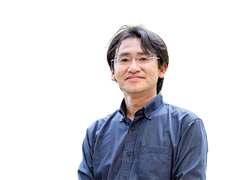
We aim to achieve sustainable operations at disposal facilities based on Japanese technology and local circumstances. When introducing waste water treatment facilities that use coconut fiber, ideas such as using the treated water to make compost and thereby not wasting it are also important. Additionally, sharing the results of the promotion of 3R activities in an easy-to-understand manner is necessary for ensuring that the project continues. Such results include not only the amount of waste reduced at final disposal sites, but also specific monetary amounts such as the profits earned from the sale of valuable resources and compost.




scroll